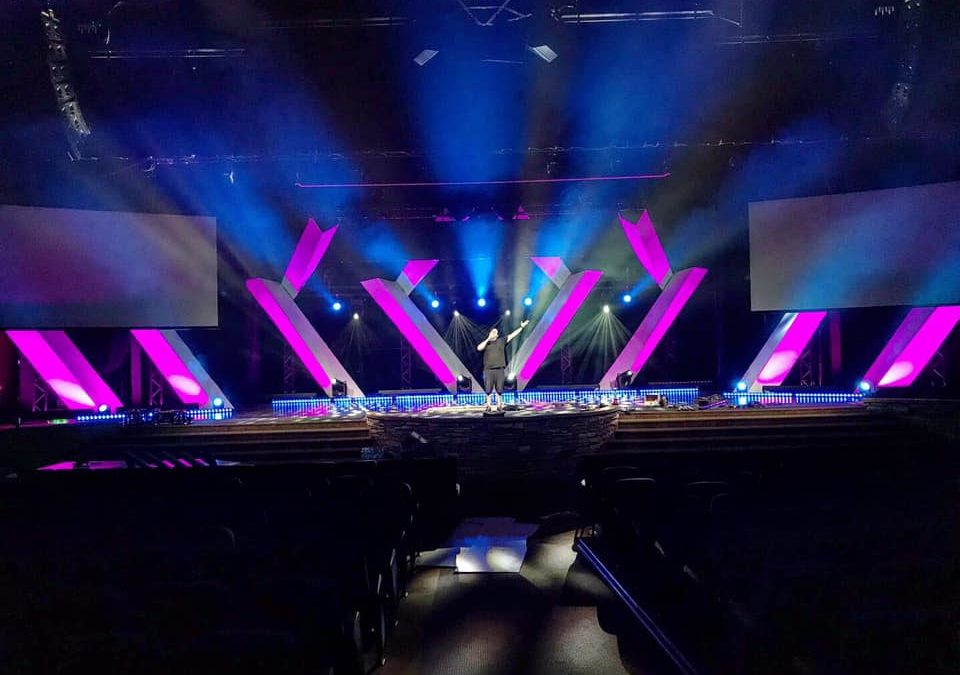Welcome to another episode of the Mod Scenes podcast. I’m your host, Steven, and I’m thrilled to chat with you today about wood, specifically about woods stage backdrops and creating a incredibly cool what stays backdrop using, um, using a light wood, uh, lightweight balsa wood. So, um, we have a, um, client who will remain unnamed. Uh, they’re a very large fortune 500 company. They have offices across the country and, um, it’s really awesome to be able to work for them, uh, but out of respect of their company. And obviously we want to keep their identity secret. So, uh, they have this really cool project, uh, with where we’re starting to work on a stage backdrop for their New York office. Um, so this is a stage backdrops for, uh, a series of teaching events that they do, um, and we’re helping them to create a visual, this really warm, uh, and really inviting.
So with that, we’re creating a wood stage backdrops. Uh, so it’s going to be a self-supporting stage backdrop, uh, that has minimal hardware usage, uh, and is, uh, super lightweight and stores in a very small space. So our goal, um, so kind of some of the, some of the goals of what we’re trying to create is we want something that, uh, has a warm look doesn’t necessarily have to be fire-rated, uh, but it does need to fit into a small closet, essentially 24 inches by 24 inch or 30 inches by 30 inches by eight foot. So, um, so what we’ve come up with is we have we found, uh, a lightweight composite, uh, it’s made of balsa wood with, uh, lewd veneers. Um, so what that is is balsa wood is a really, really lightweight wood. It’s a, um, a lot of people have used it, like in like crafts craft type stuff, uh, like specifically in like science class, probably in like seventh grade, you made a balsa wood like catapult or something.
Um, I’m sure at some point you’ve used it in, you know, a various school project or something. So it’s a very super lightweight wood. Um, but the way that this, uh, particular balsa wood that we use is created, it’s very thin veneers of in a very thin, uh, layers of this balsa wood oriented in opposing directions and glued with high, uh, high-density glue. Uh, so it’s actually the, a lot of the strength in this is actually the adhesive, the glue, because there’s so much, so many fours in this, uh, balsa wood that you kind of fill up a lot of that with the glue. Um, but an entire sheet of this stuff is like, um, it’s just a couple pounds, like four pounds. It’s crazy. Um, and once you cut it down with a design, uh, each panel is like under half a pound. It’s not.
So, um, we’re using, um, a, a design reason to design, uh, called the Sparrow panel. So it’s a, uh, uh, four elongated ellipses that meet at a central point around a sphere and a sphere, a circle, um, and with a notch cut into it so that they can stack, uh, there’s also a elongated circle at the bottom and top that are cut around, um, probably not the best to describe this one visually. Um, but at some point we’ll have pictures of the finished that without the branding on it, that we’ll be able to show. Um, so anyhow, these two pieces will, uh, since they have a notch they can make together. So to create an X shaped tower, um, they’ll make together, they put two ways on the edges, and then you can build this over and over and over again to create the sidewalls of this stage design.
Uh, and again, these entire towers are going to be in the weight. Total weight for these entire towers is going to be somewhere around six pounds, each crazy light. Um, so we have multiple of these tower type sections. That’ll create the sidewalls, uh, we’ll use, uh, bent four ways on the edges to connect them together. So they act as a single wall. Uh, and then in the middle of section, we’ll have a flat wall, uh, utilizing a custom design, which looks similar to a wooden curved wasn’t shakes. So these are, these are used to be more common and, uh, roofing like years and years and years ago. Um, now everyone uses asphalt shingles for the most part. Uh, but shapes are essentially a Cedar piece of wood. That’s, uh, approximately six inches wide, six to 12 inches long, and you nail them onto a rough overlapping and the water pours off of them essentially.
Uh, you have to have a pretty, you have to have a relatively, uh, uh, relatively steep pitch. You can’t use it on like a flat roof that would work. Uh, water would just kind of go in a little bit of everywhere. So anyhow, uh, a lot of doll house, like if you think of a dollhouse, that type of, uh, rough, that would be on a doll house, that’s similar to the kind of look that this is this, uh, these curve pieces have, but just think, oh, I think like the bottom of the Popsicle stick, maybe cut off the bottom of the Popsicle stick and put in like 19,000 of them onto a panel. That’s what we’re talking about, except for probably not quite that scale, we will each panel. So it’s modular as most of our products are. Um, each panel will have like 30 of these half circle pieces on it.
So, uh, it’s a pretty, they’re pretty wide. They’re about six inches. That’s pretty, pretty similar to like a standard, uh, standard, um, uh, rough shake. Uh, so, um, but it’s not actually roof shakes that we’re using. We’re gonna use the same bowl we talked about with a multiple panel depth. So our first panel was going to be a solid panel. It’ll be stained at dark, uh, uh, standard, dark, uh, Walnut color. And then we’ll have a second panel on top that has cutaways to create holes for the, for the, for the first panel. Uh, and it’ll also have some additional pieces that sit on top, uh, that make it look, uh, I mean, it will be three-dimensional, but it’ll, it’ll really bring out the visuals of that curved bottom, uh, shake, uh, to be able to give the visualization that there’s multiple shakes nailed together.
Um, we could have done that, but again, to cut down on weight and to make it as easy as possible to set up, we wanted to keep everything modular. So with this, uh, cause it’s the visual, uh, without all of the, uh, drawbacks of a heavier custom-built set that would need a custom hardware. Um, everything on the set will utilize our standard hardware, uh, which makes it super, uh, super easy to use and build, um, and gives our clients the ability to scale and continue to build this larger and larger as they need. Um, so yeah. Um, so, uh, we worked with our client to create this whole book. Um, so yeah, I think that, uh, I think there’s a really, I think it’s gonna be yeah, really cool site. Uh, obviously, like I said, well, we’ll, uh, show some pictures whenever we, uh, uh, whenever we get it finished before we throw the custom branding, we have some custom logo and branding.
That’s going to go on some of the sections. We’ll, we’ll grow some pictures of, uh, the build on our Facebook that you can check out, uh, in, on our Instagram. Um, so, but until then, thank you very much for checking out the Mod Scenes podcast. If you have a custom project that you’re working on, we would love to help you with, uh, you can email us@mazzianz.com. So sales@modscenes.com or call us at (530) 723-6421. Uh, we’re looking forward to serving you, uh, and thanks again for letting us talk to you about our custom statements drop products, uh, our custom wood products and how we, uh, work hard to serve our clients with stage backdrops. So, um, oh, and if you have other ideas, if you’re looking for a place to look for some new ideas on your next stage backdrop, uh, please check out, uh, Mazzi anz.com/creations. So on there, you’ll find lots of different options for using, utilizing our standard panels, uh, customizing exactly what you need, uh, and seeing how others have created really great stage backdrops for their churches, their special events, their concerts, uh they’re themed areas. Uh, so yeah, so yeah, check that out. montse.com/crayfish. Again, thanks for allowing us to serve you. It is our pleasure to be able to serve you with, uh, your stage design and the stage backdrops needs. Thanks again.


Recent Comments